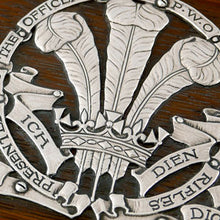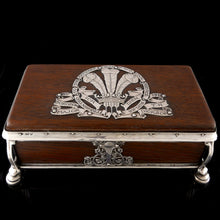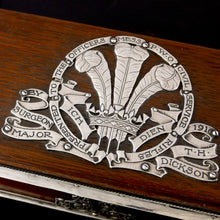Prince of Wales’s Own Civil Service Rifles - Ramsden & Carr Cigarette Box, 1910
Adding product to your cart
8.5cm (3.4in) x 23cm (9in) x 12.5cm (5in)
Hammered silver and oak. Rectangular box with hinged lid overlaid with the regimental badge of 15th (County of London) Battalion, The London Regiment, in silver and inscribed ‘Presented to the officers mess P.W.O (Prince of Wales’s Own) Civil Service Rifles by Surgeon Major T. H. Dickson 1910’. Silver mount to the underside inscribed 'OMAR RAMSDEN ET ALWYN CARR ME FECERUNT’. Maker’s mark of Ramsden and Carr. Hallmarked London 1910.
Read more
The Civil Service Rifles was one of 26 battalions of the London Regiment before the Great War. It originated with the Bank of England Volunteers, a unit raised during the French invasion scares of the 1790s, and was reformed in 1860. In 1908 it was transferred to the Territorial Force under the title of 15th (County of London) Battalion, The London Regiment (Prince of Wales's Own, Civil Service Rifles). It recruited part time volunteers employed in Civil Service departments of the Audit Office (A Company); Post Office (B & C Company); Inland Revenue (D & E Company); Whitehall (F & G Company) and the Admiralty (H Company). Regimental headquarters and companies were based at Somerset House. During the First World War it was expanded to three battalions which fought in France and Flanders, Macedonia, and the Near East. Among those conscripted into the regiment was the sculptor Henry Moore. A memorial to the fallen of the Civil Service Rifles was designed by Sir Edwin Lutyens and stands at Somerset House. The present box was appears in an illustration of the officer’s mess silver in the 1921 regimental history (The History of the Prince of Wales' Own Civil Service Rifles, p.383).
Captain Thomas Herbert Dickson RAMC (1883-1938) was the son of the Rev. T.S. Dickson, MA, of Edinburgh, and was educated at George Watson’s College and Edinburgh University (MB). He was commissioned Lieutenant, RAMC in 1909. By In 1915 he was serving in India, stationed at Rankhet, Bengal. He was promoted Captain, RAMC in 1918. Served in Mesopotamia during the Great War. He remained in the army after the war, serving in India. Died at Hope House, Tangier, Morocco.
Omar Ramsden (1873-1939) was one of the most renowned silver work designers of the first half of the 20th century. Moreover his designs have outlived many fashions and combined the ideas of art nouveau with medieval. He was born in Sheffield and was apprenticed to a silversmith before attending the Sheffield School of Art where he met his future business partner Alwyn Charles Ellison Carr (1872-1940). They were ardent followers of the Arts and Crafts movement and devout Catholics, who placed value in the hand-made over die struck creations. They won Sheffield Corporation Scholarships in 1893 and 1894 respectively, and moved to London to attend the Royal College of Art. Having won a prestigious commission to design and make the City of Sheffield ceremonial mace in 1897, they established the St. Dunstan’s workshop in South Kensington in 1898, occupying studios in Chelsea and Fulham. Liturgical work provided important commissions, and included items for Westminster Cathedral.
After the First World War Ramsden and Carr worked independently. Ramsden’s commissions came from both private individuals and public institutions. These included churches, colleges, corporations and livery companies, many with ancient lineages and heraldic devices well suited to Ramsden’s innovative yet historicist style. The Honourable Artillery Company with its Tudor origins, for example, commissioned in 1928 ten condiment sets, featuring friezes composed of portcullises and ostrich plumes taken from the HAC coat of arms. Ramsden was also the designer of a number of Great War memorials, including one at Southwark to the fallen of the London Hop Trade, and at Canterbury commemorating the Zeebrugge Raid of 1918. His silver work can be found in the British Museum and other important collection worldwide.










